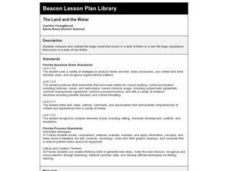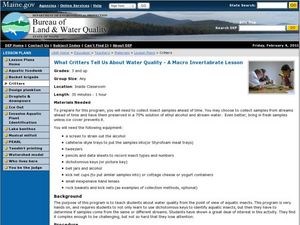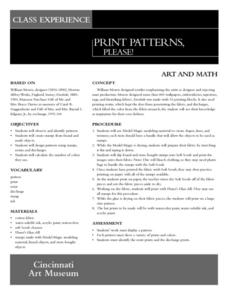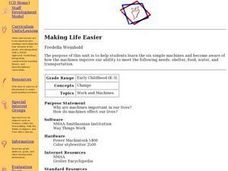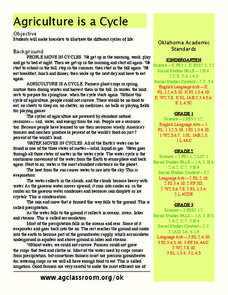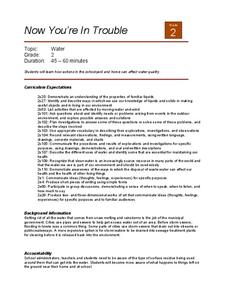Curated OER
Creature Painting
Kids create a free-form art piece using paper, water-based paints, markers, and imagination. They allow the paints to randomly bleed, mix, and move on the paper, then they look for forms in the organic images. They black-line the shapes...
Curated OER
Painting Without A Paintbrush
Students sketch a landscape scene and paint that scene using unconventional "paintbrushes" including forks, knives, squirt bottles, cotton swabs, toothpicks, water containers, and mat board.
Curated OER
The Land and the Water
Third graders read "The Land and the Water," a fictional short story and an article about John F. Kennedy, Jr. and compare and contrast fictional tragedy to a non-fiction tragedy. They fill out a Venn diagram and write an essay using...
Curated OER
Inuit Sculpture
Kids in grade four through eight research Inuit artists and art styles. After a critical look at Inuit sculpture, they use those forms for inspiration as they create one of their own. They practice using the subtractive method of...
Curated OER
Under Water Scene
Middle schoolers explore foreground and background colors. In this visual art lesson, students create an underwater collage from varying colors and textures of paper showcasing the color transition between background and foreground colors.
Curated OER
What Critters Tell Us About Water Quality: A Macroinvertebrate Lesson
Students explore our ecosystem by investigating the quality of our water. In this aquatic insect activity, students examine a group of random insects collected from different streams and ponds in the area. Students record their...
Curated OER
Early Christian Leather Working
In this leather working worksheet, students read about the leather working, answer short answer questions, draw a picture, and make a list. Students complete 4 activities.
Curated OER
VISUAL ARTS
Students learn the historical context of mask-making explore the elements of the art form.
Curated OER
Chinese Art: Botanical Motifs
Students are introduced to Chinese Art and how artists used botanical motifs. They look at slides of motifs and then create a watercolor themselves. A functional motif will be created by them and they have to provide its meanings to...
Curated OER
Working with Clay
Second graders investigate how to work with clay after examine the book "Being Friendly to Trees." They make a clay square which they decorate with leaves that they find while taking a nature walk. They glaze their artwork and then...
Curated OER
You Are What You Eat!
Pupils create believable self-portraits incorporating selected food items as details, forms, and texturesThe compositional focus is a head-and-shoulders portrait appropriate to the food theme resulting in a humorous illustration. Written...
Art Institute of Chicago
Send a Postcard
Using Claude Monet's On the Bank of the Seine as inspiration, young artists create their own postcards. During the lesson, learners discuss the techniques used in Monet's painting, as well as the woman in the painting, and...
Curated OER
The Great Art of Henri Matisse
Students discover the artistic works of Henri Matisse, and examine what his work means. In this art lesson, students observe the different paintings/collages of Henri Matisse, eventually creating works of their own based on his style.
Curated OER
Natural Beauty: Looking Sharp
Students create covers for their "nature journals" using watercolor techniques and the artistic ideas of color, depth, and focal point. This lesson can be used in the Science or Art classroom and meets national standards for both.
Curated OER
Print Patterns, Please!
Students practice the art of stamping and pattern design in this lesson using cotton fabric, ink, acrylic paint, watercolors, Elmer's Glue, and Model Magic. Emphasis is placed on the creation of individual student stamps and cooperative...
Curated OER
Language Arts Quiz B-Grade 4
In this grade 4 language arts quiz activity, 4th graders complete a 15 question multiple choice quiz covering a variety of grade 4 concepts.
Curated OER
Folk Art Weather Vane
Students create replicas of Folk Art Weather Vanes using farm animal outlines, cardboard or wood, paints, and staining techniques. Emphasis is placed on the appreciation of folk art, the history of the weather vane, and creativity.
Curated OER
Near and Far Snow People/an Art lesson
Pupils explore the concepts in art of near and far by drawing landscapes and snowpeople. They first draw and later do watercolor and oil pastel paintings.
Curated OER
See Spot Run
Students identify several properties of water as a universal substance, describe the composition of several complex color mixtures and separate the components of dye using chromatographic technique.
Curated OER
Making Life Easier
Students use a chart of the six simple machines and become aware of how the machines improve our ability to meet the following needs: shelter, food, water, and transportation. Students use model cars to experiment with force. They divide...
Curated OER
"101 Amazing Earth Facts" Game
Students read for comprehension, work cooperatively to learn "101 Amazing Earth Facts," and compete as teams in a Jeopardy-like game.
Curated OER
Agriculture is a Cycle
Young scholars explore cycles in nature. In this cross curriculum agriculture lesson, students define "cycle" and research weather and planting folklore. Young scholars make a bracelet in which individual colored beads represent the many...
Curated OER
Now You're In Trouble
Second graders study how actions in the schoolyard and home can affect water quality. They discuss how rainwater can clean plants and sidewalks on its way to storm sewers. They draw an example of a simple maze that represents the maze...
Curated OER
Oh, Let the Rain Fall Down
Fifth graders explain the three phases of the water cycle in a narraive paragraph where they describe the journey of a single raindrop. They are introduced to five science vocabulary words and personfication.


